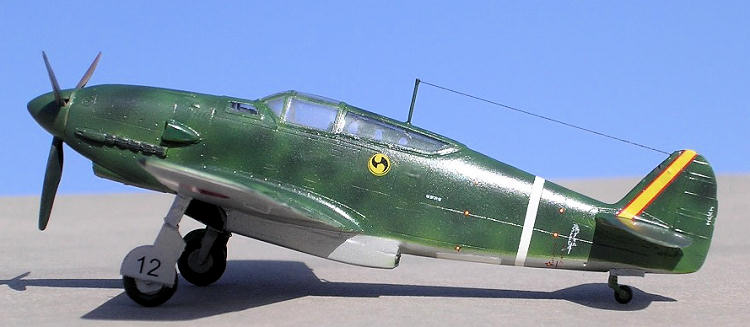
RS Models 1/72 Kawasaki Ki-60
| KIT #: | ? |
| PRICE: | 29.99 euros |
| DECALS: | Two options |
| REVIEWER: | Carmel J. Attard |
| NOTES: | Injection molded with photo etch fret |

| HISTORY |
The
Kawasaki Ki-60 was a Japanese WWII fighter aircraft that used a license-built
DB-601
liquid-cooled engine. The majority of Japanese aircraft at
that time used air-cooled radial engines. The Ki-60 was designed by Takeo Doi
and his deputy Shin Owada of Kawasaki Kokuki Kogyo K.K. (Kawasaki Heavy
Industries) in response to a 1939 Koku Hombu
(Army Air Headquarters) requirement for a heavily armed specialized interceptor
fighter to be powered by the liquid cooled DB 601 inverted V12 engine which had
been selected for license production by Kawasaki as the HA-40. The emphasis in
the requirements was for a high speed and a good rate of climb, along with a
cannon armament. This was a complete change from the usual IJAAF penchant for
lightly armed, highly manoeuvrable fighters with lightweight structures,
epitomized by the Ki-27 and the later Ki-43. A requirement was issued at the
same time for a lighter, less heavily armed, general-purpose fighter which was
to be designed almost in parallel with the Ki-60; this became the Ki-61 Priority
was to be given to the Ki-60, design of which started in February 1940.
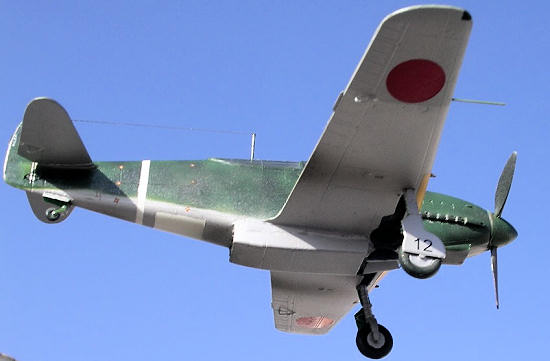 The
first prototype of the Ki-60 emerged in March 1941 as a compact, all metal,
stressed skin monoplane with a relatively deep fuselage (1.46 m (4 feet 9.5 in))
and tapered wings with rounded tips built around a system of three spars; a
Warren Truss main spar and two auxiliary spars. The
rear spar carried the split flaps and long, narrow chord ailerons, while the
front spar incorporated the undercarriage pivot points. The undercarriage track
was 3 metres (9 ft 10 in). The pilot's seat was mounted high over the rear spar,
giving the fuselage a distinctive "humped" profile; the hood featured a framed,
rear sliding canopy and an elongated rear transparent section. The main coolant
radiator was housed in a long ventral bath under the wing centre-section and
central fuselage, while the oil cooler was mounted under the engine with a long
air intake. The prototype was powered by an imported DB 601A as production of
the Ha-40 had not yet started. A total fuel capacity of 410 l (90.2
Imperial
gallons)) was carried.
The
first prototype of the Ki-60 emerged in March 1941 as a compact, all metal,
stressed skin monoplane with a relatively deep fuselage (1.46 m (4 feet 9.5 in))
and tapered wings with rounded tips built around a system of three spars; a
Warren Truss main spar and two auxiliary spars. The
rear spar carried the split flaps and long, narrow chord ailerons, while the
front spar incorporated the undercarriage pivot points. The undercarriage track
was 3 metres (9 ft 10 in). The pilot's seat was mounted high over the rear spar,
giving the fuselage a distinctive "humped" profile; the hood featured a framed,
rear sliding canopy and an elongated rear transparent section. The main coolant
radiator was housed in a long ventral bath under the wing centre-section and
central fuselage, while the oil cooler was mounted under the engine with a long
air intake. The prototype was powered by an imported DB 601A as production of
the Ha-40 had not yet started. A total fuel capacity of 410 l (90.2
Imperial
gallons)) was carried.
The armament
carried was two fuselage mounted 12.7 mm caliber Ho-103 machine guns which were
set in a "staggered" configuration (the port weapon slightly further forward
than that to starboard) in a bay just above and behind the engine. One German
made Mauser MG151/20, 20 mm cannon was housed in a weapons bay in each wing.
With a normal loaded weight of 2,890 kg (6,371 lb) and a gross wing area of 15.9
m² (171.15 ft²) the wing loading was 181.76 kg/m² (37.23 lb/ft²), which was
extremely high by Japanese standards (the standard IJAAF fighter, the Ki-27, had
a wing loading of 70 kg/m² (14.33 lb/ft²).
From the start
of flight testing it became apparent that the design was seriously flawed in
several key areas. The take-off run was unacceptably long, while in flight the
aircraft displayed some lateral instability, excessively heavy controls and poor
control response. The spinning characteristics were described as "dangerous" and
the stalling speed was extremely high. Although a
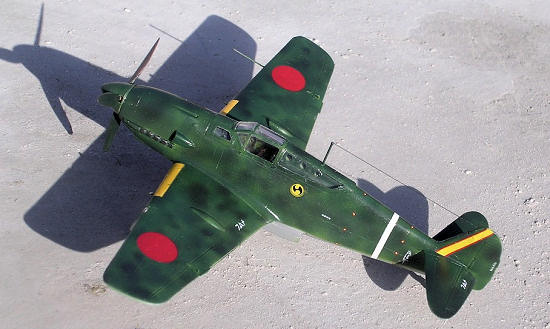 top
speed of 600 km/h (373 mph) had been projected the Ki-60 was only able to
achieve 548 km/h (340 mph).
top
speed of 600 km/h (373 mph) had been projected the Ki-60 was only able to
achieve 548 km/h (340 mph).
As a
result the second and third prototypes, which were still being built, were
hurriedly modified in an attempt to mitigate some of the more undesirable
traits. Some 100 kg (220 lb) was removed, primarily by replacing the MG151
cannon with Ho-103 machine guns, reducing the normal loaded weight to 2,750 kg
(6,063 lb). Coupled with a slight increase in wing area to 16.20 m² (174.376
ft²) this resulted in a slightly lower wing loading of 169.7nbsp;kg/m²
(34.76 lb/ft²). Detail changes were made to airframe sealing and to the contours
of the air intakes and radiator bath. Flight tests were still disappointing,
with both of the modified prototypes displaying most of the shortcomings of the
first. A top speed of only 560 km/h (348 mph) was reached, with a climb rate
still well below specifications. By this time the Nakajima Ki-44, which had also
been designed as a dedicated interceptor, was beginning to show some promise and
the Koku Hombu
selected this in fulfillment of its requirements. From early 1941 the full
attention of Takeo Doi and Shin Owada was focused on the Ki-61; the Ki-60 became
important in that the Ki-61 design was able to be improved using the lessons
learned from the poor characteristics of the Ki-60.
| THE KIT |
 for the
adventurous modeller who is prepared to go for anything as long as it is not a
Spitfire or a Bf-109. On the contrary some may think that it is another Tony
Ki-61 when in fact it was the prelude for the Hien Ki-61. The
Ki-60 prototype in fact proved disappointing and was soon abandoned. Efforts
were then concentrated on an alternative design, the Ki-61
for the
adventurous modeller who is prepared to go for anything as long as it is not a
Spitfire or a Bf-109. On the contrary some may think that it is another Tony
Ki-61 when in fact it was the prelude for the Hien Ki-61. The
Ki-60 prototype in fact proved disappointing and was soon abandoned. Efforts
were then concentrated on an alternative design, the Ki-61
| CONSTRUCTION |
Construction starts with detailing the cockpit which consists of a floor, a two
part seat, control column, seat straps, rudder pedals, instrument panel, two
tiny aiming sights, and instruments to fit to sides of cockpit walls. More
detail parts are fitted at stage 5. You need a set of tweezers to go about stage
3 which deals with the assembly of the main undercarriage each of which consists
of 6 items. The front air intake and another one to port side of nose are
carefully represented and parts fit together so
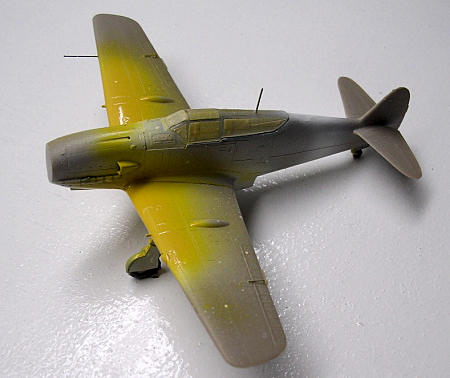 well
that it is worthy of praise with no need for any filler anywhere and all that is
needed is a little rubbing down on the fuselage joint lines.
well
that it is worthy of praise with no need for any filler anywhere and all that is
needed is a little rubbing down on the fuselage joint lines.
The exhaust outlets on both sides of nose are separate items. These fit into elongated apertures and one should fit on the inside blank pieces so that the exhaust items will not fall inside or pressed too far in when being fitted in place. There is a semi-circular headrest support. This has a nicely moulded central plate containing three round holes in it. This detail is clearly visible from the clearly moulded canopy that comes with the kit. Incidentally the canopy has a front extension so that when this is painted it leaves two rectangular spy holes which is a feature that is quite unusual on fighters. A three bladed prop and spinner are finely reproduced.
The kit has a belly air intake and an interesting aspect added to it is that there are detail etch items to fit at the intake and another filter inside aft. I preferred to replace the wing and the fuselage aerial with steel ones. The last items to go on the kit were the control links at the aileron, elevators and rudder areas indicated on the instructions. This is another delicate step which when accomplished look very effective.
| COLORS & MARKINGS |
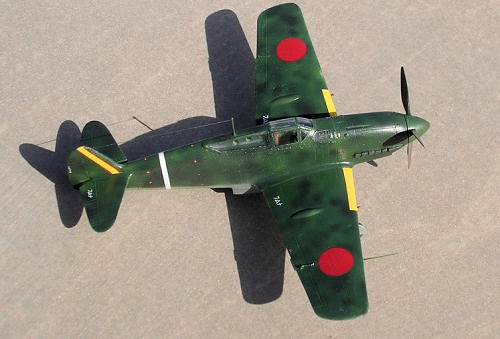 Colour
detail is indicated on the kit box cover. There are plan views for either an all
silver prototype or silver under surface and green mottle upper surface Ki-60
that was based in
Colour
detail is indicated on the kit box cover. There are plan views for either an all
silver prototype or silver under surface and green mottle upper surface Ki-60
that was based in
| CONCLUSIONS |
| REFERENCES |
September 2008
Copyright ModelingMadness.com. All rights reserved.
No reproduction in part or in whole without permission from the editor. If you would like your product reviewed fairly and fairly quickly , please
contact
the editor or see other details in the
Note to
Contributors.